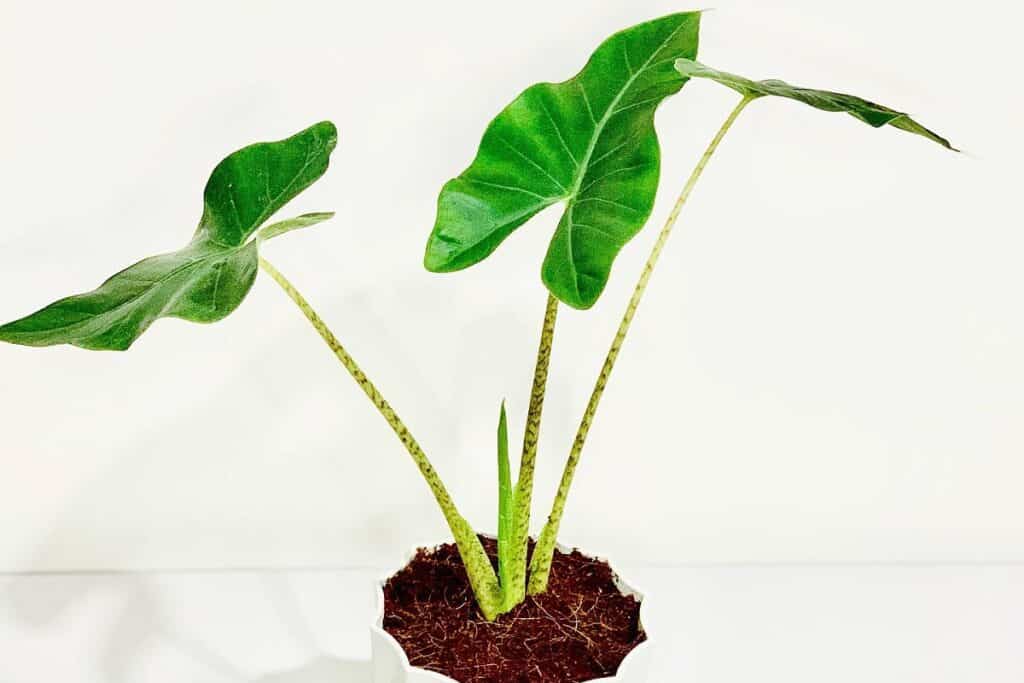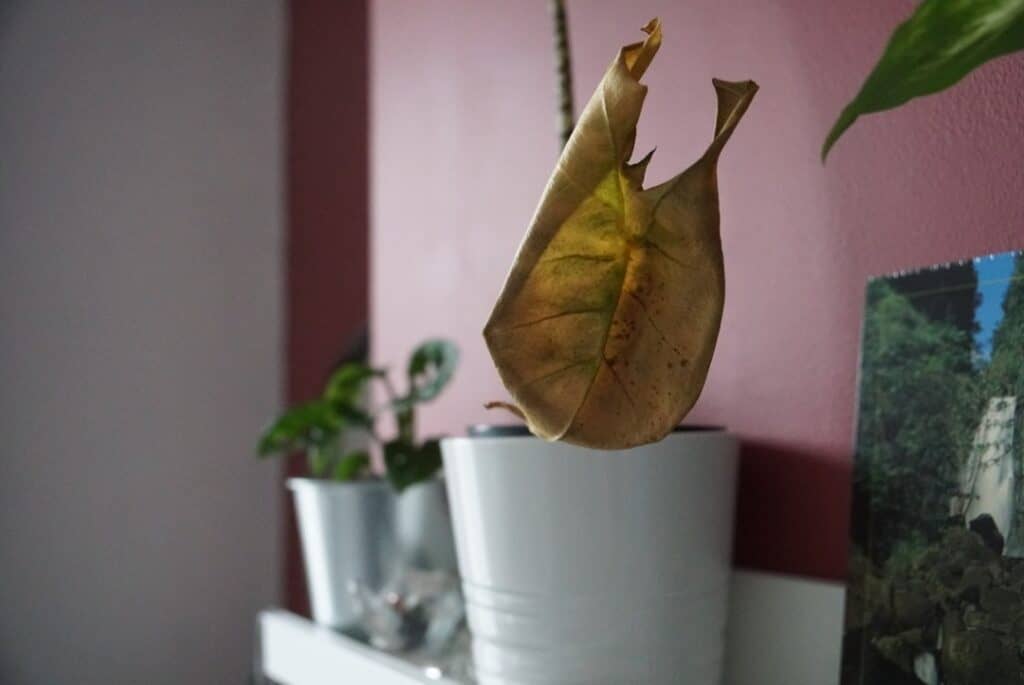Alocasia Zebrina brings a lush tropical vibe to our homes… until one day the music stops and the plant begins to wilt and fall off. Why is this happening? Does Alocasia Zebrina go dormant?
Let’s unravel the mystery of Alocasia Zebrina dormancy to see why it happens and how it can be managed.
Alocasia Zebrina dormancy is when the plant stops growing and stagnates or dies. It is a natural process, driven by less light, lower temperatures and dry air and soil. It will grow back when warm, bright and humid conditions return. Dormancy can be delayed or induced.

Contents
- 1 What is Alocasia Zebrina Dormancy?
- 2 Why Does Alocasia Zebrina Go Dormant?
- 3 What Does A Dormant Alocasia Zebrina Look Like?
- 4 What To Do When Alocasia Zebrina Goes Dormant?
- 5 When To Prune Dormant Alocasia Zebrina?
- 6 Coming Out Of Dormancy
- 7 How To Prevent Alocasia Zebrina From Going Dormant?
- 8 How To Induce Dormancy In Alocasia Zebrina?
What is Alocasia Zebrina Dormancy?
The dormancy in Alocasia Zebrina is natural and while it’s ugly, there’s no need to worry. Most plants go through some form of dormancy—only Alocasia Zebrina can go to extremes.
Visually, the plant seems to be doing nothing… but that is not the case! As the plant enters a new phase of activity, its metabolism begins to slow down. Despite low temperatures, roots can store energy, convert starch, and establish the foundation for future growth.
While some plants rest in the heat of summer, others, including Alocasia Zebrina, go dormant when temperatures and light levels drop.
The concept of winter dormancy refers to efficiency: new leaves are produced during warmer and brighter conditions, and slower growth is experienced when conditions are less favorable. Oftentimes, the leaves simply stop growing, or they may droop as they slowly turn yellow.
Why Does Alocasia Zebrina Go Dormant?
The Alocasia Zebrina goes dormant because it senses the winter is coming, whether it’s true or not. Its broad, sun-kissed leaves are difficult to maintain in the winter, so it starts withering.
Your Alocasia Zebrina is likely to enter dormancy for a number of reasons:
- The process begins with shorter daylight hours and less intense light.
- Temperatures below 15°C can cause dormancy if held for more than a week. (The plant can recover from a short period of cold.)
- The air is drier in cold weather and plays a role in early dormancy (albeit a less significant one).
- Dormancy is also triggered by a drop in soil moisture in cold weather, although drought alone does not cause it.
As long as your Alocasia Zebrina does not receive these signals, it will generally not enter dormancy. Indoors, plants often remain evergreen in warm, well-lit conditions.
There is no harm in dormancy for plants, and sometimes they even go dormant for good reasons. Dormancy is normal, and it may even be a healthy, necessary cycle for plants.
What Does A Dormant Alocasia Zebrina Look Like?
Alocasia Zebrina plants have varying levels of rest, depending on their environment. In a climate-controlled environment such as our home, Alocasia Zebrina should never show signs of rest.
In order to properly care for the plant, you must recognize the signs of dormancy:
- When the light and temperature change in the fall, indoor Alocasia Zebrina usually stops growing. The leaves become dull and droopy, but they do not completely die back. The plant will quickly rebound when growing conditions improve.
- Alocasia Zebrina that enters full dormancy will die, leaving only a bare pot with a corm in it. This can take place if the plant sits near a window and experiences seasonal changes in light and temperature. Dry, heated air is another factor.

Is my Alocasia Zebrina dormant or dead?
After reading about Alocasia Zebrina’s problems, many people assume the worst, tossing the helpless plant into the trash—not realizing that it just needs some rest. And there will be people who wonder why there are exotic leaves in the landfill the following year.
Don’t let it be you! To know whether your Alocasia Zebrina is dying or dormant, be sure to inspect the roots:
- Dead Alocasia Zebrina roots will rot and become mushy, or become dried and brittle.
- Dormant Alocasia Zebrina leaves behind a firm tuber with a sweet scent waiting for their mark to return.
What To Do When Alocasia Zebrina Goes Dormant?
When your Alocasia Zebrina is dormant, it is important to provide it with proper care. Here are a few basics:
1. Reduce Watering
In the event your Alocasia Zebrina stopped growing, it is important to reduce watering. As the plant consumes less water, you do not want it to sit in moist soil during dormancy, as pathogens and rot don’t rest. It is generally recommended to leave the soil slightly dry during dormancy. The goal is to keep the roots barely moist; a sip of water every two or three weeks is usually enough. Allow the topsoil to dry further before watering again.
2. Reduce Light
As the plant is resting, it also needs less light, so keep it away from intense lighting. However, bear in mind that if it still has leaves, the reduced light will cause the plant to go completely dormant.
3. Provide Cold Conditions
Dormant plants tend to be in low temperatures, so don’t expose them to abnormal heat when dormant. You don’t have to go to extremes, just keep them away from drafts and hot appliances.
4. Monitor for Pests
The dormant Alocasia Zebrina plant is a convenient target for hungry beetles, especially in warmer temperatures. Examine the plant regularly for signs of infection. Avoid using poisonous chemicals on the plant by using diluted alcohol sprays, horticultural oils, or insecticidal soap.
5. Alocasia Zebrina Bulb Care
The amount of light won’t matter if your Alocasia Zebrina is just a bulb… but watering is essential! Keeping the bulb alive requires a moist bulb in a cold and relatively dry soil. Make sure the soil stays moist before it completely dries out. Rot is the biggest concern.
When To Prune Dormant Alocasia Zebrina?
You may be tempted to prune leaves that lose color and look awful, but it’s better to leave them as they are. It is common for plants entering dormancy to take nutrients from their leaves in order to store them in their roots. Trimming leaves can limit the plant’s preparation for a new growth cycle.
Also in some cases, the leaves are still working at a reduced level during the dormancy period. Once dormancy is over, the leaves should spring back to life, which will save the plant time and effort and help it to mature faster.
Coming Out Of Dormancy
As soon as the plant is ready to start a new cycle and when the conditions are right, it will end its dormancy period. Watch for new growth in the Alocasia Zebrina that indicates dormancy completion.
- When the plant is starting to wake up indoors, make sure it gets enough water and is placed in a bright place with ample light. It is also best to increase its humidity during this time.
- The temperature of the soil mixture is more important than the ambient air temperature. It needs to be at least 70°F (21°C).
- For some Alocasia Zebrina plants, a stronger wake-up call is necessary. The next step is to cover the pot with clear plastic and place a heat mat under it.
As soon as you see the plant responding with new growth, return to your usual watering pattern. Do not fertilize until you see the plant return to normal.

How To Prevent Alocasia Zebrina From Going Dormant?
In order to keep your Alocasia Zebrina evergreen, you need to maintain uniform growing conditions. Luckily, this isn’t difficult at home, where even just a bit of effort will make your plant never die out.
- During winter, Alocasia Zebrina plants that depend on natural light from the window are likely to suffer from reduced daylight hours. To avoid this, use a grow light with a timer.
- Alocasia Zebrina should survive winter without any drastic changes if you keep the internal temperature above 70°F (21°C).
- In heated homes, the air is dry, which encourages dormancy. Make sure to maintain a high humidity level for your plants.
- Another factor triggering dormancy is dry soil, and internal heating tends to dry soil within a shorter period of time. Well-drained soil allows you to water as needed without leaving sluggish roots.
- While conventional wisdom suggests stopping fertilizing during the cold season, you can feed plants that produce new growth by using very diluted fertilizers.
While it’s desirable to prevent dormancy from an aesthetic point of view, don’t expect to keep your Alocasia Zebrina indefinitely in the growing cycle. Seasonal dormancy is natural. The priority is preventing complete leaf loss.
How To Induce Dormancy In Alocasia Zebrina?
Occasionally, although it may seem odd, sometimes it’s advisable to let your Alocasia Zebrina plants rest. For example, you may want to move a bulb rather than a potted plant…or your collection may be infested with spider mites.
By mimicking the conditions that cause dormancy, you can induce it.
- Reduce the brightness of the room. Move the plant away from the light source or pull the curtains.
- Reduce watering gradually, but do not let the soil completely dry out.
- Find a cooler place or lower the thermostat a couple of degrees.
Alocasia Zebrina can be put into dormancy anytime, but it is safer and easier to do so after a normal growing season. Lastly, while inducing dormancy is not difficult, it is recommended for those who are more experienced in growing Alocasia Zebrina.
